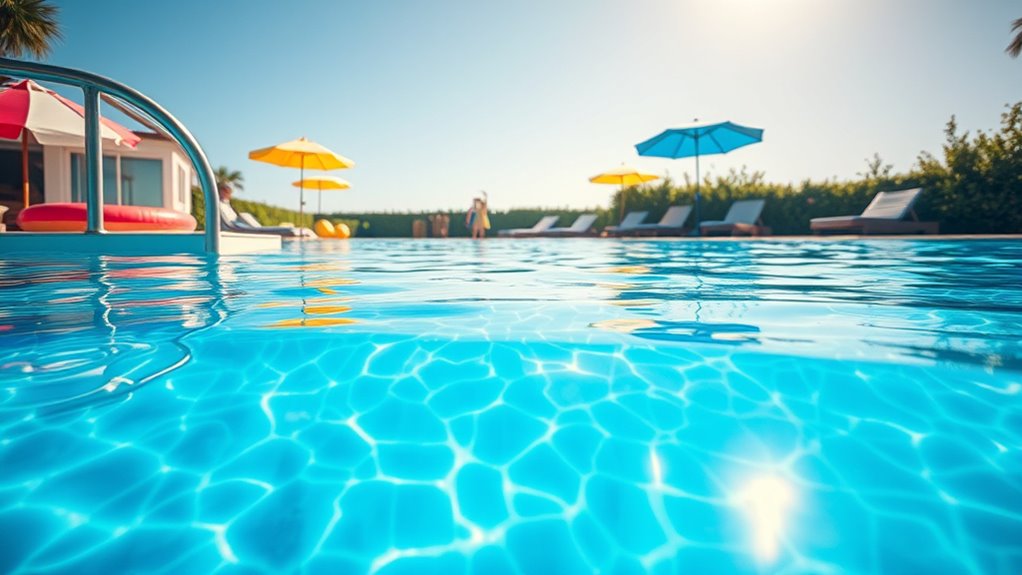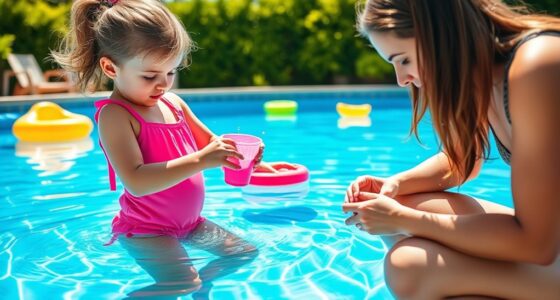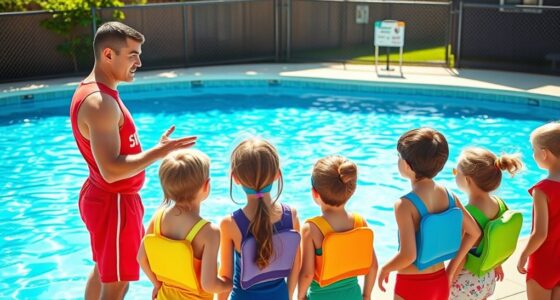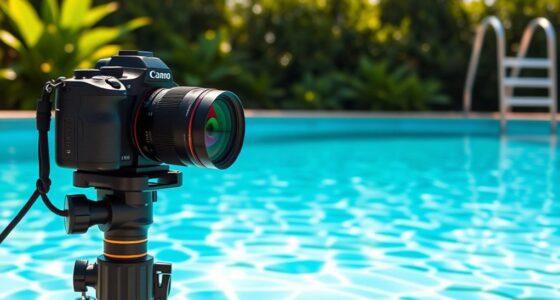Many common pool myths can lead you to neglect proper maintenance and safety. For example, you don’t just need to shock your pool occasionally—regular shocking keeps the water hygienic and inviting. Myth claims that pool covers alone keep you safe or that sunlight doesn’t affect chlorine—both are false. Understanding how chemicals, pH, and circulation work together is key to a healthy pool. Stay tuned to uncover more truths that can help you enjoy a safer, cleaner pool year-round.
Key Takeaways
- Proper chemical balance and regular testing are essential for safe, clear water; myths about skipping chemicals can cause hazards.
- Chlorine remains the most effective disinfectant; alternatives like UV and mineral systems support but do not replace traditional chemicals.
- Pool covers are safety aids but should not replace fences, alarms, or supervision for comprehensive pool safety.
- Sunlight accelerates sanitizer breakdown, requiring more frequent chemical addition; stabilized chlorine helps mitigate UV effects.
- Maintaining correct pH and circulation prevents algae buildup, cloudy water, and health issues, debunking myths about “easy” pool maintenance.
Debunking the Myth: You Don’t Need to Shock Your Pool Regularly
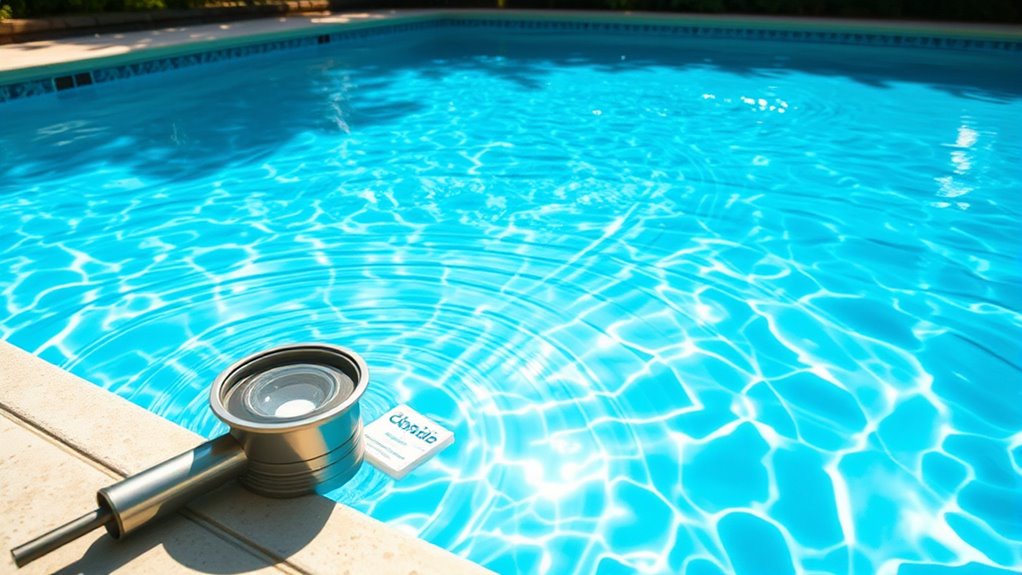
Many pool owners believe that shocking their pool regularly is unnecessary, but this isn’t true. The chlorine necessity is vital for maintaining a safe, clean swimming environment, especially when it comes to chemical maintenance. Shocking your pool helps break down organic contaminants, chloramines, and bacteria that standard chlorine levels might miss. Without regular shocking, these impurities can build up, leading to cloudy water, unpleasant odors, and skin irritation. It’s a key part of proper chemical maintenance, ensuring your pool stays hygienic and inviting. It’s also important to note that high-quality projectors with proper calibration can help you monitor water conditions visually through your pool’s surroundings. Skipping this step may seem convenient, but it compromises water quality and safety. Regular shocking isn’t just a myth — it’s essential for a healthy, balanced pool. Staying on top of this task saves you headaches in the long run. Additionally, understanding chemical balance is crucial for effective pool maintenance and safety. Proper water testing methods are vital to ensure your pool remains safe and well-maintained.
Clarifying the Truth: Chlorine and Other Chemicals Are Always Necessary
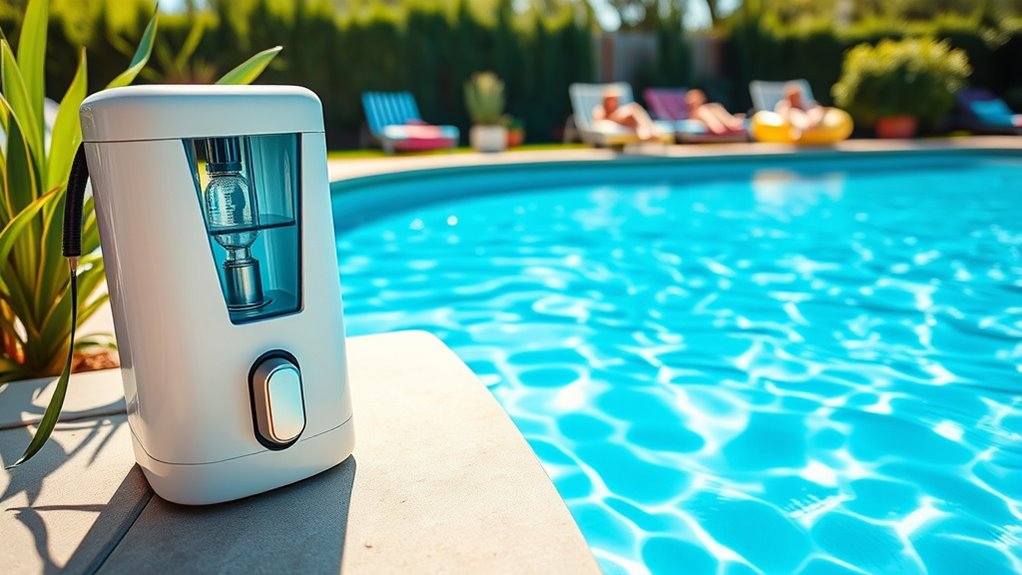
You might think you can skip chemicals and still keep your pool clean, but maintaining proper chemical balance is essential for safety and clarity. Chlorine remains the most effective disinfectant, although alternatives like saltwater systems or UV filters can assist. Understanding why chemicals are necessary helps you choose the right approach for a safe, healthy pool. For example, essential oils should not be used as disinfectants because they lack the proven antimicrobial effectiveness required for pool sanitation. Additionally, controlling pH levels is crucial for ensuring chlorine efficacy and preventing algae growth. Regular testing of water chemistry helps maintain optimal chemical balance and prevents issues such as cloudy water or algae buildup. Proper water testing ensures that all chemical levels stay within safe ranges, reducing the risk of health hazards and maintaining pool clarity. Maintaining proper chlorine levels is vital to effectively kill bacteria and prevent pathogens from thriving in the water.
Chemical Balance Importance
Maintaining proper chemical balance in your pool is vital for safe and clean water. Regular water testing helps you monitor pH, alkalinity, and sanitizer levels, guaranteeing everything stays within ideal ranges. This step is essential because imbalanced chemicals can cause cloudy water, algae growth, and skin irritation. Proper chemical dosing keeps your pool safe and prevents issues before they start. Consistently adjusting chemicals based on test results maintains a stable environment for swimmers and protects your pool equipment. Remember, skipping water testing or neglecting chemical adjustments can compromise water quality. By prioritizing chemical balance, you ensure your pool remains inviting, hygienic, and safe for everyone to enjoy. Proper maintenance saves time, money, and headaches in the long run. Regular filter replacement and monitoring air quality indicators also help maintain optimal performance of your pool’s filtration system. Additionally, understanding the importance of chemical balance can help prevent long-term damage to your pool surfaces and equipment. Maintaining water quality through proper chemical management is crucial for extending the lifespan of your pool and ensuring a pleasant swimming experience. Incorporating pool chemistry knowledge can further enhance your ability to maintain a pristine swimming environment.
Alternative Disinfection Methods
While alternative disinfection methods are gaining popularity, chlorine and other traditional chemicals remain the most reliable way to keep pool water safe. UV sterilization uses ultraviolet light to kill bacteria and viruses, reducing chemical reliance but not replacing them entirely. Mineral purifiers, often containing copper or silver, can help inhibit algae and bacteria growth, offering a supplementary approach. However, these methods alone may not eliminate all pathogens or maintain consistent water quality, especially in high-use pools. You still need chlorine or similar chemicals to guarantee thorough disinfection and proper pH balance. Alternative methods can reduce chemical usage but shouldn’t replace traditional disinfection entirely. Combining these techniques can improve water quality, but always follow safety guidelines and testing routines to ensure your pool remains clean and safe for swimming.
Myths About Pool Water Temperature and Comfort
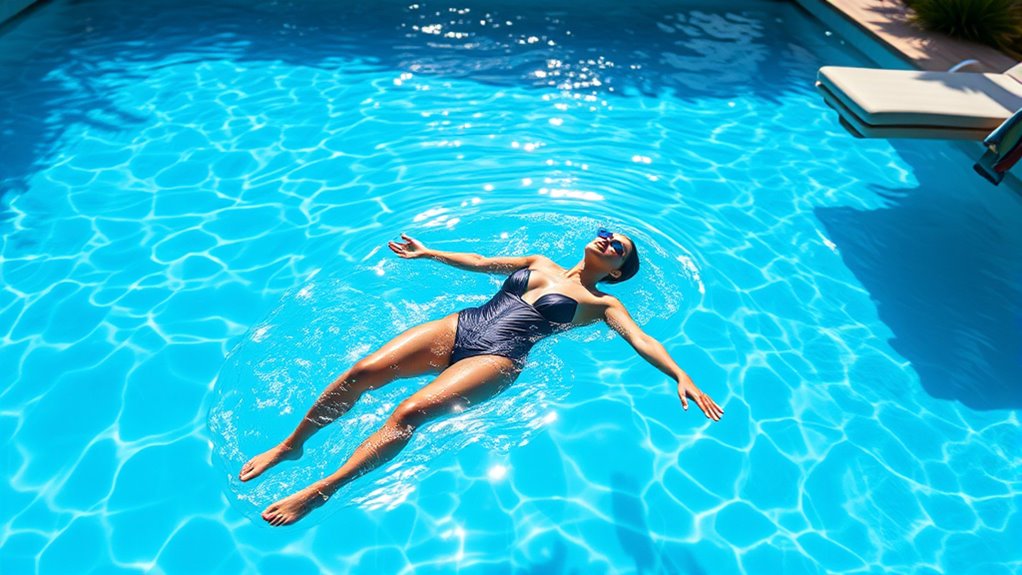
Many people believe that a specific pool water temperature guarantees maximum comfort, but this isn’t always true. While warmer water often feels more inviting, overshooting the ideal temperature can cause discomfort or even health issues. Relying solely on solar heating may not achieve consistent warmth if water circulation isn’t effective; stagnant water cools quickly and creates uneven temperatures. Proper water circulation is essential to distribute heat evenly, ensuring your pool feels comfortable throughout. A moderate temperature, around 78-82°F, generally offers the best balance of comfort and safety. Additionally, water circulation systems can significantly influence temperature consistency and overall comfort. Remember, temperature preferences vary, so adjust based on your activity and climate. Don’t assume that increasing temperature always improves comfort—effective water circulation and appropriate heating are key. Optimal pool temperature can vary depending on individual preferences and pool use.
The Reality Behind Algae: Is It Always Caused by Dirty Water?
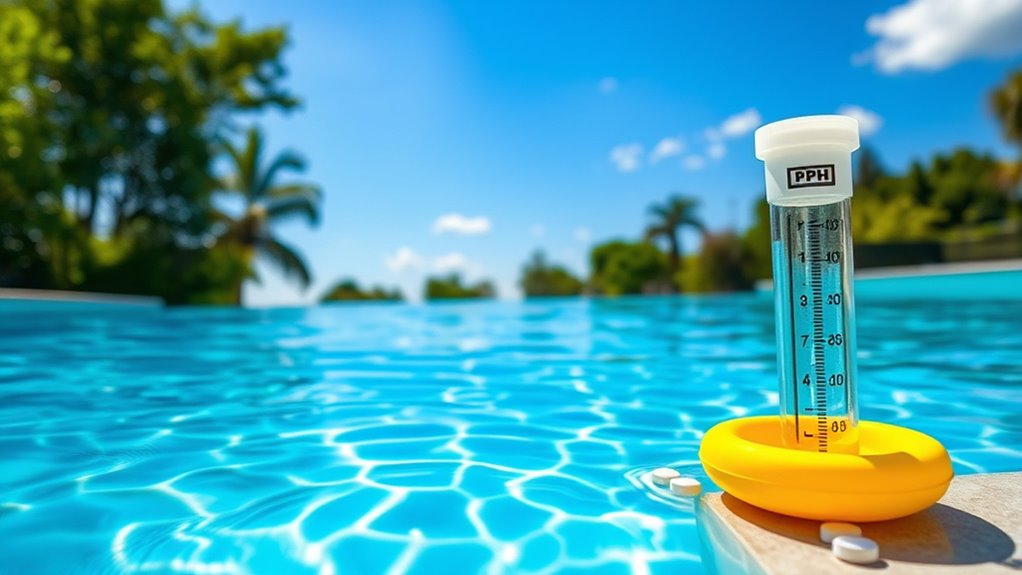
Algae growth often gets blamed solely on dirty water, but the reality is more nuanced. While poor water clarity can indicate algae presence, algae can also thrive in well-maintained pools if conditions aren’t ideal. Factors like sunlight exposure, nutrient levels, and insufficient circulation contribute to algae outbreaks, regardless of water cleanliness. Effective algae prevention involves regular chlorination, proper filtration, and maintaining consistent sanitizer levels. Keeping water clear isn’t just about aesthetics; it’s a key indicator of good pool health. Even with diligent cleaning, algae can still appear if the chemical balance isn’t right. Pool maintenance practices, such as checking chemical levels regularly and ensuring proper circulation, play a crucial role in preventing algae growth. Additionally, understanding water chemistry is vital for maintaining optimal conditions that discourage algae development. For instance, monitoring nutrient levels can help prevent excessive algae nourishment. So, don’t assume dirty water is the sole cause—focus on proper maintenance to keep algae at bay and ensure your water stays crystal clear. Understanding the factors influencing algae growth can help pool owners take proactive steps.
Understanding Ph Balance and Its Impact on Pool Maintenance
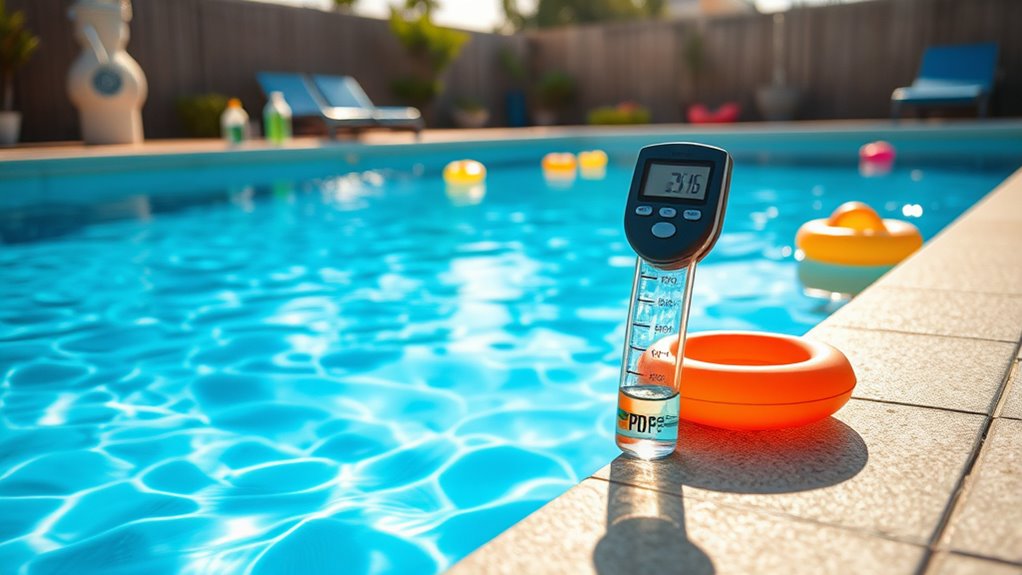
Have you ever wondered how pH levels influence your pool’s clarity and safety? Maintaining proper pH balance is essential because pH fluctuation can cause cloudy water, scaling, and irritation to swimmers’ eyes and skin. When pH drifts too high or low, chlorine becomes less effective, making it harder to disinfect the water properly. That’s why alkalinity control is vital; it acts as a buffer, preventing sudden pH swings. Regular testing helps you catch pH fluctuations early, so you can adjust with pH increasers or decreasers as needed. Keeping your pool’s pH between 7.2 and 7.6 ensures peak clarity, comfort, and sanitation. Proper pH management isn’t just about water quality—it’s about kidney stone prevention and protecting your investment and creating a safe swimming environment.
Common Misconceptions About Pool Covers and Safety
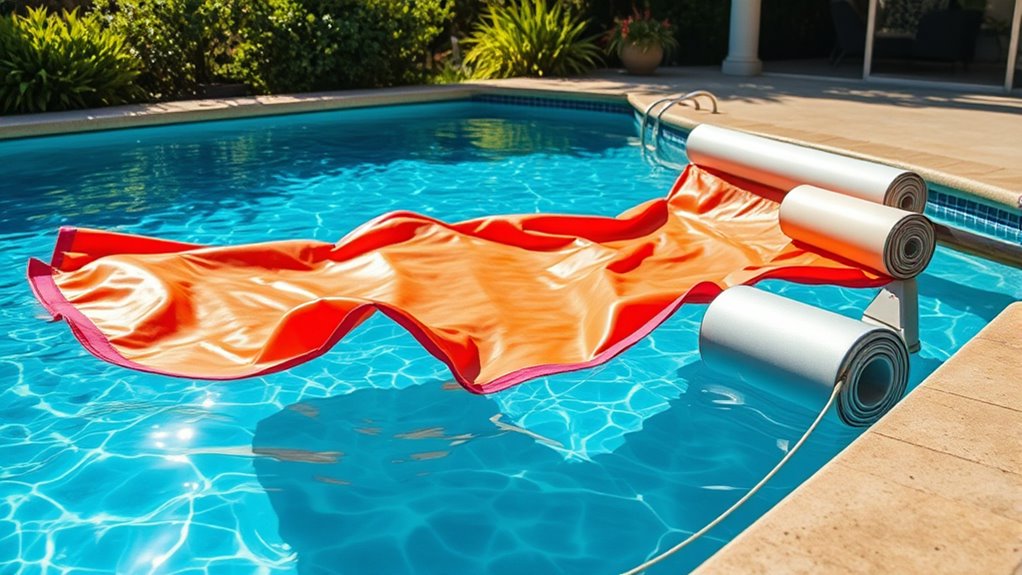
Despite common beliefs, pool covers are not foolproof safety devices. While solar covers help retain heat and reduce evaporation, they shouldn’t replace safety fencing or supervision. It’s important to recognize the safety limitations of pool covers and always prioritize comprehensive safety measures. Relying solely on pool covers can give a false sense of security, especially with solar covers that aren’t designed to prevent accidents. It’s also essential to understand how pool safety features, such as alarms and secure barriers, work together to protect swimmers. Educating pool users about credit card security and proper safety protocols can further reduce risks associated with pool area access and potential emergencies. In addition, understanding the home furnishings that support safety, such as secure fencing and alarms, is crucial for a comprehensive safety approach. Incorporating annuity strategies can also help ensure financial stability for families in case of emergencies or unforeseen events affecting safety investments.
The Truth About Pool Filtration and Circulation Systems
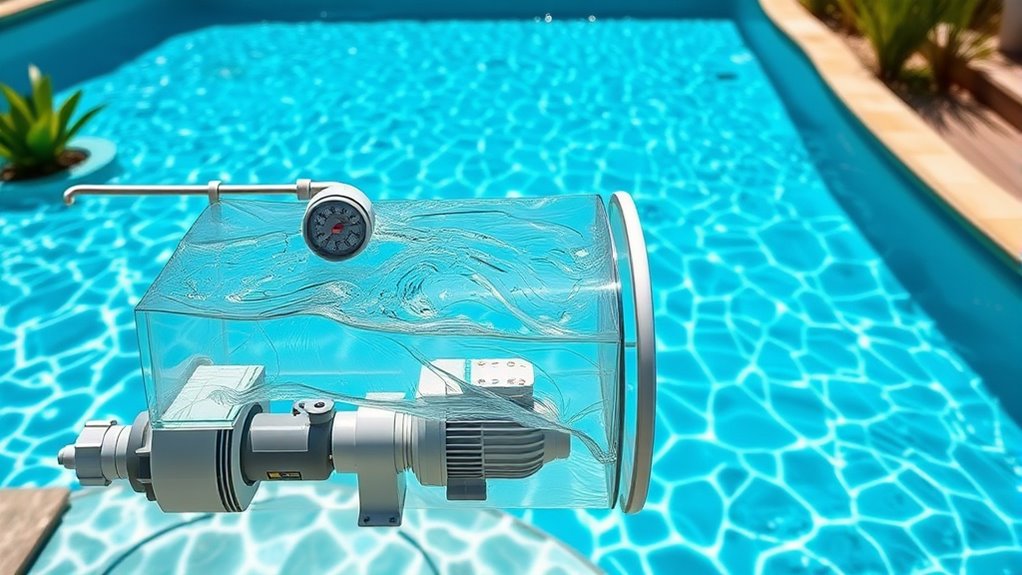
Understanding how your pool’s filtration and circulation systems work is essential for keeping the water clean and safe. Proper pool circulation ensures chemicals evenly distribute, preventing algae and bacteria growth. Filtration systems remove dirt, debris, and microscopic contaminants, maintaining water clarity. To optimize these systems, keep these points in mind:
Proper circulation and filtration keep your pool clean, clear, and safe.
- Regularly run your pool pump for at least 8 hours daily to promote effective circulation.
- Clean or backwash filters frequently to prevent clogging and maintain efficiency.
- Ensure skimmers and returns are unobstructed for continuous flow and circulation.
Separating Fact From Fiction: the Effect of Sunlight on Pool Chemicals
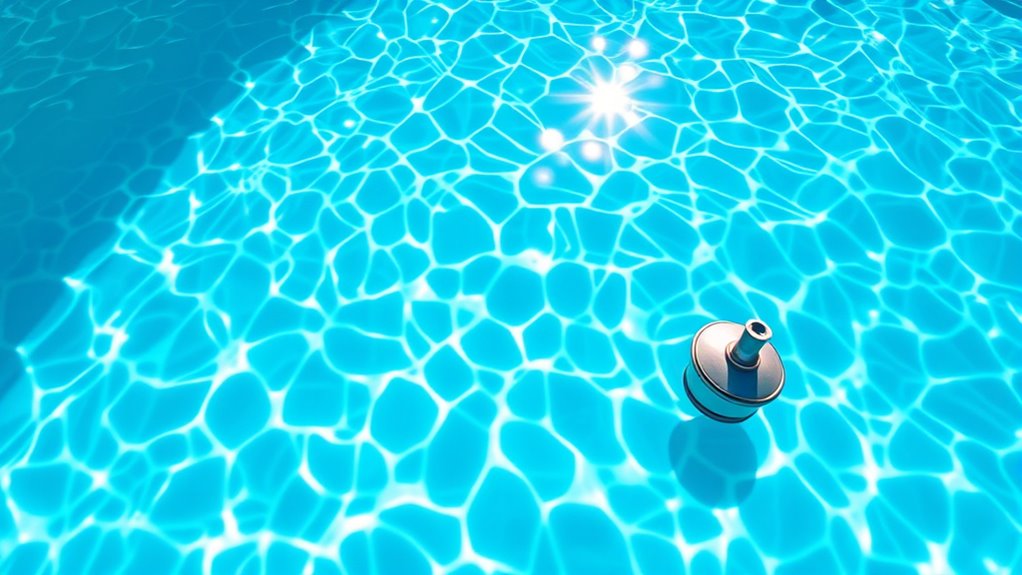
Ever wonder how sunlight impacts your pool chemicals? Sunlight can cause sunlight degradation, reducing the effectiveness of chlorine and other disinfectants. UV oxidation breaks down chemical compounds, making sanitizers less potent over time. When your pool is exposed to direct sunlight, UV rays accelerate this process, leading to faster chemical dissipation. This means you’ll need to add chemicals more frequently to maintain proper water balance and sanitation. To minimize the effects, consider using a pool cover when the pool isn’t in use or choosing stabilized chlorine that contains sun protection. Understanding UV oxidation helps you better manage chemical levels and keeps your pool safe and clear, despite the challenges sunlight presents. Additionally, self-watering plant pots utilize reservoirs and capillary action, which can help maintain consistent moisture levels, similar to how stabilizers help keep pool chemicals effective under sunlight. Recognizing the importance of chemical stability allows pool owners to take proactive steps in maintaining water quality.
Frequently Asked Questions
How Often Should I Test My Pool’S Chemical Levels?
You should test your pool’s chemical levels at least 2-3 times a week to guarantee pool safety and maintain a proper maintenance schedule. Regular testing helps prevent algae growth, bacteria, and other issues. Check chlorine, pH, alkalinity, and stabilizer levels, adjusting as needed. Consistent testing keeps your pool inviting, safe, and reduces long-term maintenance costs, making pool ownership more enjoyable and worry-free.
Can Natural Pool Methods Replace Chemical Treatments?
Sure, natural pool methods sound charming, but don’t expect them to replace chemical treatments overnight. You’ll rely on natural filtration and maintaining biological balance to keep your water clear, but it’s a delicate dance. Without proper chemical adjustments, algae and bacteria might take over, turning your dream into a swamp. So, while natural methods help, they usually work best alongside traditional treatments for a sparkling, safe swim.
What Are the Signs of Improper Pool Water Circulation?
You’ll notice signs of improper pool water circulation when the water flow seems weak or uneven, causing stagnant spots. Poor circulation can lead to cloudy water, algae buildup, and algae growth. If your skimmer isn’t pulling debris effectively or the pump sounds unusual, it’s a clear sign your pool circulation needs attention. Ensuring proper water flow keeps chemicals balanced and prevents algae, so check your pump and jets regularly to maintain ideal circulation.
Does Pool Size Affect Chemical Requirements?
Did you know that larger pools require up to 50% more chemicals? Your pool volume directly impacts chemical dosage; bigger pools need more chlorine, pH adjusters, and stabilizers to maintain clarity and safety. Smaller pools, on the other hand, need less. So, always measure your pool’s size accurately to prevent over- or under-chemicaling, which can lead to issues like algae growth or skin irritation. Proper chemical balance depends on your pool size.
Are There Eco-Friendly Alternatives to Traditional Pool Chemicals?
You might wonder if eco-friendly alternatives like biodegradable chemicals or saltwater systems can replace traditional pool chemicals. These options reduce environmental impact and are gentler on your skin and eyes. Saltwater systems generate chlorine naturally, minimizing chemical use, while biodegradable chemicals break down quickly, preventing pollution. Switching to these alternatives helps you maintain a clean, safe pool while supporting sustainability efforts and protecting the environment.
Conclusion
Now that you’ve unraveled these pool myths, you’re armed with the truth to keep your oasis sparkling. Think of your pool as a delicate dance—balancing chemicals, temperature, and circulation like a seasoned performer. Busting these myths clears the fog, letting your backyard paradise shine brighter than a summer sun. Immerse yourself with confidence, knowing you’re the maestro of your pool’s health, turning misconceptions into crystal-clear reality.

